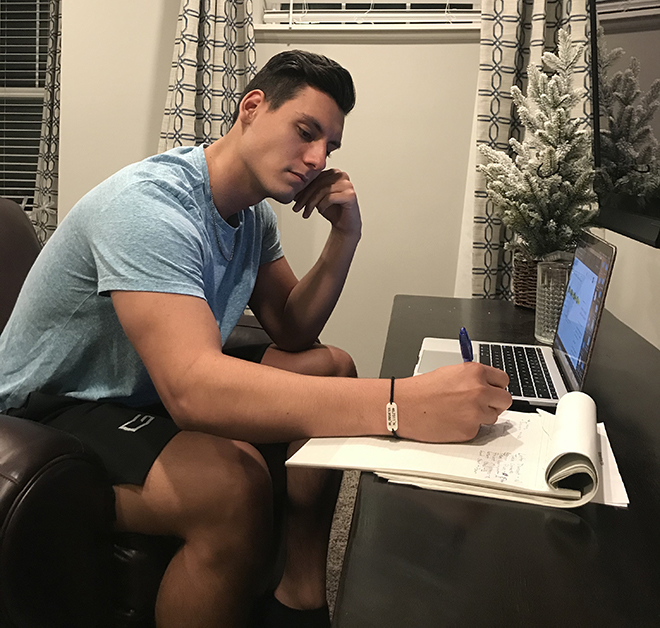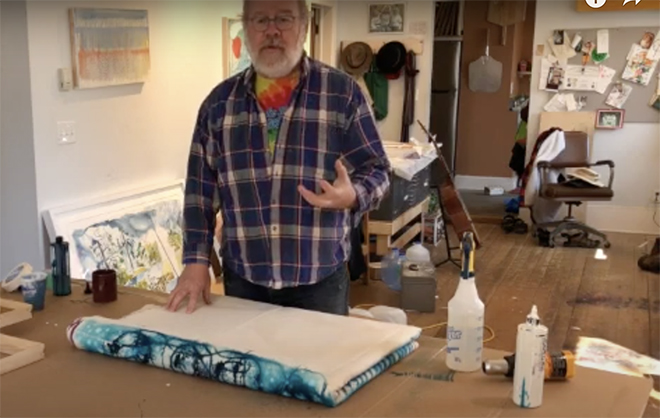It was less than ideal. That much was acknowledged by Interim Provost Matt Cecil when he passed along the information to instructors to begin planning going to online instruction in March.
“We recognize that this creates enormous challenges,” Cecil wrote of the move to online. “It is going to require creativity and innovation in order to help our students succeed…Our goal must be to create learning opportunities that, while not ideal by any measure, address our students’ needs and keep them on schedule for graduation.”
As the Information Technology Solutions division went to work ensuring the new demands on the system would hold, thousands of students and instructors had three weeks to essentially retrofit their teaching and learning into an online format.

And as the experiment continues into summer, nobody’s claiming the situation is ideal. But faculty the first move impressively by most accounts.
“It’s pretty amazing,” Cecil said near semester’s end. “Is it perfect? No. Everybody agrees it’s not perfect and its certainly not the experience we want those students to have in those classes. … That said, we’ve heard mostly good reviews. Students have told us they think their faculty members are doing the best they can.They understand it’s an emergency situation.”
SUBSTITUTE LAB
Ordinarily in her Human Physiology class, Rachel Cohen’s first-year students have a fairly fun time measuring aspects of their own physiology such as respiration and blood pressure. When they no longer had access to the lab’s equipment, Cohen had other data for them to analyze at home. In terms of enthusiasm, it was a clear letdown.
“We have student data from previous semesters – so what we’ve done to move to online is instead of having the students do the fun part, which is the data collection part, they get the data to analyze. So I guess we took the fun part out of lab.”

“It’s sort of working,” she added, “but just from what interactions I have had with the students, they don’t like it. I don’t like it either. “
Throughout the early stages of the transition, President Richard Davenport heard daily from students, and his take on the switch was that the sooner the teaching can return to normal the better.
“Initially they were OK with online, but my general sense is they’re not looking forward to this in the future,” Davenport said.
Cohen’s move to online fared a bit better in her RISEbio course, designed to give first-year students lab research experience. Without access to labs, students have been using videos provided by the company that produces devices and software used in class. In addition, Cohen has created optional meetings on the Zoom platform with student lab sections.
Similarly, nursing students whose internships relied on hands-on work in the University’s Maverick Family Nursing Simulation Center were able to satisfy requirements by utilizing the high-tech capabilities of the center. Students were able to watch and study simulations filmed earlier in the center of former nursing students at work.
The pivot has been a significant one for her, Cohen said, noting the list of to-do items grows longer as she tends to work mentoring research students, chairing a search committee and staying in touch with hundreds of students.
“I feel every day like I’m barely keeping my head above water,” she said.
President Richard Davenport knows the feeling.
“I do think it’s going to get tiring to continue with all-remote teaching online,” he said. “Not only for the students but the faculty as well.”
THE ART OF CHANGE
Art instructor Brian Frink tends to grade students in first-year drawing and painting classes on their interaction with each other and with him in the art studios. With that missing in spring, he asked them to look inward – and draw what they discovered.
“In this very unique moment in human history, it would be nice of them to reflect what they’re going through,” Frink said. “So I’m having them do what I’m calling an Armageddon Journal or an Apocalypse Journal and just journaling every day, doing drawings. I set that as a basis for all three classes.
In laying out expectations for his students to journal, he also made sure they didn’t sweat grades. Everybody in his class received an A.
“If we do this next fall, and God help us if we do, then I have to figure out a different way to make them accountable for what they do through grading. But it was so sudden and so severe and just kind of BOOM, I thought well, we’re just going to move forward and not worry about grading.”
A CHANGE IN BUSINESS PLANS
Sophomore business student Nick Eull is the CEO of Noble Ice, a company he and fellow students created in the Integrated Business Experience. In that program, students create actual companies – taking out bank loans, creating marketing plans and, ideally, making a profit. Noble Ice produced backpack coolers and other items, and the sales plan was based entirely on selling them at campus events.
Then all those events were canceled.
“It was hard getting everyone on the same page when everyone’s kind of spread out at home, now, and some people are across the country and some people are still in Mankato,” Eull said from his parents’ cabin in Elk River.
Through Zoom meetings with fellow company members, they re-tooled their sales plan by everybody taking a direct approach with their own contacts – friends, family, anybody – to make sales.
“We were able to adapt,” Eull said. “We’ve had to do a little bit more outreach and a little more work to sell some of them. But we’ve still been able to make all our money back, paid back our loan and stayed on top of everything.”
SAM’S STORY
Art student Sam Brown received an undergraduate research grant for a work that wound up being too big to take home. His 6-foot-by-6-foot painting became off limits with the stay-at-home orders.
He’s not only missing the work, he’s missing the give-and-take of Frink’s art class.
“I would interact with other students who probably had total different philosophies on art and total different viewpoints on the meaning behind their art,” Brown said.
“That mini-culture in that studio spot, interacting with print makers and drawing students, ceramicists, sculptors … Interacting with all those other art people and people working in those different mediums has gone away and it’s just kind of by myself. It’s isolating.”
Brown is nonetheless creating works – considerably smaller in size than his research project – while finding some fresh work in perspective.
“It feels kind of refreshing in a certain sense,” he said. “You get a bit of a moment to slow down, and then just take in life for a little bit.”
Davenport stresses that campus is ready to get back to classroom delivery in fall. And he’s guessing students will be grateful for the return to hands-on learning.
“The sooner we get back to offering live classes – which I hope will be in the fall, and we’re planning on that – it will make a huge difference about how our students feel about higher ed. And they’ll probably come back with a much more sober sense of how important their education is.”
Speak Your Mind